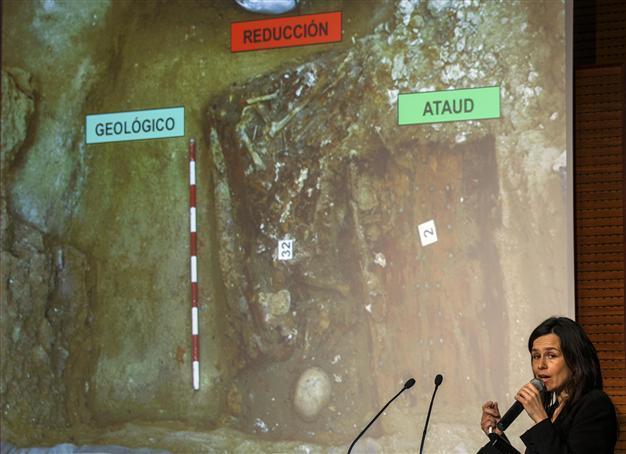Spain finds remains of 'Don Quixote' writer Cervantes
MADRID - Agence France-Presse

Forensic anthropologist Almudena Garcia speaks about the search of the remains of Spanish writer Miguel de Cervantes, in front of a picture of its probable location, in Madrid March 17, 2015. REUTERS Photo
Spain on March 17 unearthed the apparent remains of literary giant and father of the modern novel Miguel de Cervantes, found in a Madrid convent almost 400 years after his death.Forensic anthropologist Francisco Etxeberria said that after a year-long search his team had positively identified in an alcove in a convent crypt "some fragments" of the Spanish "Don Quixote" author who died in 1616 a week after William Shakespeare.
Though there is no genetic proof of the find at this stage, Etxeberria's team of anthropologists and archaeologists said they were confident of the claim on the basis of the documentary research they carried out.
They based their findings on fragments "discovered in the ground of the crypt of the current church of the Trinitarians," Etxeberria said.
Archeologist Almudena Garcia-Rubio said there was "no confirmed genetic identification".
Etxeberria however said "we are convinced that we have amid these fragments something of Cervantes."
In January the team announced the discovery of a casket at Madrid's Convent of the Barefoot Trinitarians during excavations aimed at solving the mystery of the writer's final resting place.
A fragment of a board of one of the caskets had the letters "M.C." formed in tacks, they said.
Cervantes is recorded as having been buried at the convent's chapel in the centre of the Spanish capital a day after his death on April 22, 1616, but the exact whereabouts of his grave were unknown.
Etxeberria's team launched in April 2014 what is the first significant search for the remains of the greatest writer of the Spanish Golden Age.
Using infrared cameras, 3D scanners and ground-penetrating radar, they identified 33 alcoves where bones could be stored.
Born near Madrid in 1547, Cervantes has been dubbed the father of the modern novel for "The Ingenious Gentleman Don Quixote of La Mancha", published in two parts in 1605 and 1615.
His influence on the Spanish language has been so great that the language is often referred to as "the language of Cervantes".
But his impact has also gone well beyond Spanish, particularly in the development of the novel as an art form.
The commonly used phrase "tilting at windmills" -- meaning to target imaginary enemies -- also originated from the adventures of Don Quixote.
Cervantes spent his last years in a Madrid district now called the "Barrio de las Letras" (the Arts District) in homage to the writer as well as to his 17th century rivals Lope de Vega, Francis de Quevedo and Luis de Gongora.
The area at the time was home to writers, actors and playwrights, said historian Fernando de Prado who was involved in the bid to find Cervantes' tomb.
Cervantes was shot twice in the chest and once in his left hand during a 1571 naval conflict, the Battle of Lepanto, in which the Holy League led by Spain defeated the Ottoman fleet. His bones would still show signs of the injury.
















